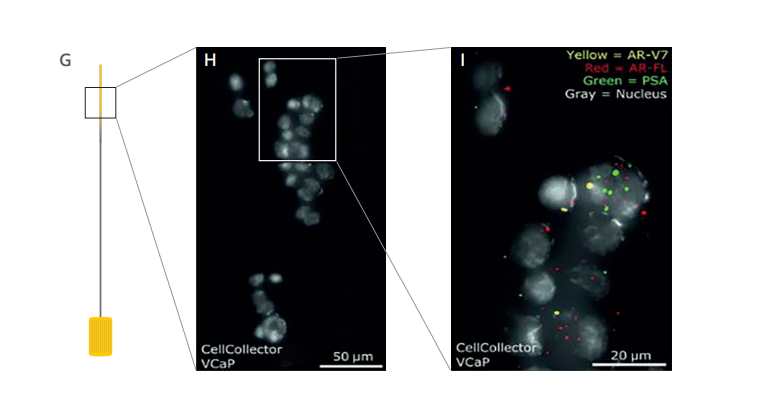
Verified Lab Services
Efficient Lab Techniques
Diagnostics Services developed in Potsdam
Our innovative products and services enable optimal characterization of existing diseases. In addition to the focus on diagnostic services for patients with prostate cancer, we also offer additional diagnostic services for patients with other types of cancer, as a foundation for personalized medicine.
Prostate Cancer – Clinical Challenges
Supporting Treatment Decision Making
Once prostate cancer has been diagnosed, the risk of disease progression needs to be determined. A risk determination regarding the aggressiveness of the disease and the associated general risk for the patients life. In addition to the classic parameters such as tumor size, PSA value (blood parameters) and Gleason score (degree of tissue change), more and more innovative parameters are also being examined. The focus of the classic parameters has so far been mainly on conventional biopsies that are obtained from solid tissue. However, sampling circulating cells from the blood (e.g. tumor cells) has also been integrated into the clinic in recent years. This highly innovative form of sample collection is also known as “liquid biopsy” and can provide additional and, above all, current information about the actual disease status. Even if the tumor is no longer present.


Liquid Biopsy in Clinical Practice
Circulating Tumor Cells in Prostate Cancer
Analysis of circulating tumor cells (CTCs) can provide additional information for improved treatment decisions. In the field of slowly growing tumors that do not currently require treatment but do require observation, treatment is the so-called active surveillance. Here, CTCs can be used as a diagnostic supplement to detect changes in the disease at an early stage and thus be able to react in a timely manner by adapting the treatment strategy. For more aggressive prostate tumors that require treatment, the big challenge is to find an individual and suitable treatment solution. To enable personalized medicine, the specific characteristics of the patient's disease must be known. Here, CTCs represent a diagnostic tool that can provide real-time information about changes in the cancer. In this way, specific and individual treatment concepts that are specifically tailored to the individual patient can not only be created but also flexibly adapted.
Innovation in Diagnostics
PSMA Determination in Prostate Cancer
In addition to determining the PSA value, PSMA also plays an essential role in prostate cancer. PSMA stands for prostate-specific membrane antigen. The increased presence (so-called expression) of PSMA plays a central role in the development and progression of prostate cancer. PSMA represents an important therapeutic target and a suitable parameter for therapy monitoring. But especially in advanced prostate cancer cases, there is usually no tumor left that can be accessed while disease progression. CTCs can close this diagnostic gap. The detection of PSMA on the surface of CTCs is closely related to the response to certain therapies. Various PSMA-targeted therapies are now available, such as PSMA-targeted radioligant therapies, antibody-based therapies and cellular immunotherapies, which can have a highly specific effect on PSMA-positive prostate cancer. The enrichment of CTCs and the detection of PSMA on their surface is possible with the GILUPI CellCollector® platform and subsequent diagnostic evaluation via immunofluorescence staining is already available to patients today.
GILUPI Technology
In Practice
Innovative Diagnostics for Prostate Cancer
During the treatment of prostate cancer, clinical decisions and clinical research are often based on risk assessment for all conditions of the disease. Localized tumors can range from those with low malignant potential (which are unlikely to cause death or shorten life expectancy if left untreated) to those that are curable with a single therapy directed exclusively at the tumor itself. Up to those that tend to recur despite therapy. Regardless of the status of prostate cancer, there are various markers (disease-specific properties) that influence the choice of treatment, the response to therapy and other clinical parameters. GILUPI's range of services includes the markers listed here that can be examined on CTCs.
- PSMA - Prostate Specific Membrane Antigen
- AR-V7 - splice variant 7 of the androgen receptor
- AR - androgen receptor
- PD-L1

Immunofluorescence Microscopy
Identification & Counting of CTCs
Immunofluorescence microscopy is a powerful method for determining special properties and the location of structures in a cell. For that, fluorescently labeled antibodies are used, which bind to certain cell components and make these structures visible under the microscope through special excitation with light. The microscope images on the left are selected from a pancreatic cancer showing isolated and stained CTCs. Staining with fluorescent antibodies against EpCAM/keratins (green), gives a positive signal in tumor cells. CD45 (red) is a typical marker for blood cells, but is not found in tumor cells. The cell nucleus appears blue. Epithelial tumor cells are positive for EpCAM and/or keratins and negative for CD45. Thus, the CTCs can be distinguished from blood cells. The scale bar corresponds to a length of 10 μm.
NuPlex® Technology
Detection of Gene Transcripts in CTCs
In addition to the classic immunofluorescence microscopic evaluation, CTCs can be examined at the genetic level using an innovative method. The NuPLex® technology enables detection of ribonucleic acids (RNA) in tumor cells with the highest level of accuracy. Among others RNA plays a significant role in the formation of surface markers typical of CTCs. With the NuPLex® method used by GILUPI, the cells are analyzed directly inside for tumor-specific target sequences. These target sequences are amplified directly in the cells via with a specific molecular tool . In a further step, the cells and the target structures can be visualized at the genetic level using fluorescent probes and a special microscope.


Next Generation Sequencing – NGS
Comprehensive analysis of DNA sections in CTCs
“Next generation sequencing” (NGS) refers to genetic analysis procedures that can sequence a very large number of DNA molecules in parallel. Sequencing is one of the most important standards in genetics and is used, for example, to detect mutations. In principle, CTCs enriched with the GILUPI CellCollector® can be analyzed via NGS. The establishment of the combination of NGS with the GILUPI CellCollector® is currently in process. Research publication on this are already available.
